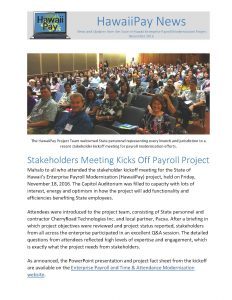Enterprise Programs and Projects

HawaiiPay News — Click this image to read the Enterprise Payroll Modernization project’s monthly newsletter.
Enterprise Programs and Projects consist of initiatives identified as enterprise in scope, leveraging economies of scale and setting standard platforms for IT systems to maximizing positive return on investment (e.g., tax, health and human services, asset management, budget, finance, grants, human resources, payroll, procurement, and time and attendance).
Programs and Projects:
-
- Tax Modernization – The Tax Department is undergoing a major modernization effort to transform its operations and meet the rising expectations of today’s taxpayers. The Tax System Modernization program is a collection of projects slated for completion by 2020. Currently, rollout four is underway which includes individual income, partnership, fiduciary, estate and transfer. While the Tax Department is spearheading the modernization efforts, ETS oversees the technical aspects of the project.
- HawaiiPay Project – More than 65,000 State employees are enrolled in the modernized payroll system. Pay statements are now delivered online to all employees, significantly reducing paper and distribution costs. Electronic W-2 forms are available for the first time online, giving employees a choice between electronic or paper copies. The project was being implemented by the Department of Accounting and General Services in coordination with the Office of Enterprise Technology Services.
- Time and Leave – The state completed the implementation of a new electronic time and leave system that creates greater accuracy and efficiency in its payroll process in Oct. 2021. About 13,000 employees in the Executive and Legislative branches, and the Office of Hawaiian Affairs are using the new system. Over 90,000 electronic leave records now flow through the automated system each month, and electronic timesheets are used to auto-calculate overtime and other types of pay. Timesheets and leave requests are now transmitted electronically to the State’s Central Payroll Office, replacing the 40-year-old paper-based, labor-intensive tracking methods in employee pay calculation. The new functionality, which integrates seamlessly into the HR and payroll systems, processes pay more efficiently and with greater consistency than the manually calculated timesheets of the past, and employees now have visibility to their paid leave benefits with each pay period. The project was implemented by Hawaii Modernization Initiative, which is under the purview of the Department of Accounting and General Services (DAGS), in coordination with the Office of Enterprise Technology Services (ETS).
- Finance – The HiMod office also launched the Enterprise Finance System (EFS) modernization project in November 2019 with the release of a Request for Proposal (RFP) for a new statewide system. Upon the selection of the system and integrator, the State will direct the design and build of the new finance system and modern processes and functionality over the next few years. The modernization project will replace the finance and budget systems and promote business process re-engineering in the areas of general ledger, encumbrances, accounts payable, accounts receivable, cash management, purchasing. Additionally, core systems and interfaces will be replaced for invoicing, projects, award management, bonds and investment management, asset inventory management and grant management in the initial Core phase.
- Department of Education – The Hawaii State Department of Education (HIDOE) is leading the state’s effort by modernizing its Financial Management System (FMS), a vital accounting platform that processed more than $1.5 billion in payroll transactions and $840 million in non-payroll transactions for HIDOE in fiscal year 2019. The executive branch’s goal is to align all state departments under a common accounting structure, enabling increased efficiency and transparency. While DOE is spearheading the modernization efforts, ETS oversees the governance aspects of the project.
- Paper Reduction Pilot Program – A six-month paper reduction program piloted by the Office of Enterprise Technology Services has reduced paper use by 20 percent, which translates to a savings of one million sheets of printed paper. Nine state departments participated in the limited scope pilot, which took place from January 2018 to June 2018. During the same period the year before, more than 4 million sheets of paper were used.One of the ways paper use was reduced was transitioning departments into producing electronic reports instead of printing hard-copy documents. Additional paper reductions and cost savings are expected in the coming months as more departments eliminate many printed paper reports entirely and convert others to digital documents. In three years, the State is projected to save $500-thousand and 10 million sheets of printed paper.
- eSign – Keeping government functions operational during a disaster or emergency is a key objective of the State of Hawaii preparedness plan. Technology services that enable employees to work remotely and through the web will be highly important during these situations. Cloud computing and hosted applications or Software as a Service (SaaS) allow workers to access the software and data they need remotely from outside of the office.Adobe Sign is one such SaaS service that allows workers to facilitate the signing of documents securely and legally through the web. Workers can continue to process documents that require signatures without the need to print, manually route, or wet sign, keeping essential business processes timely and flowing.Through eSign, the amount of paper the government uses have been significantly reduced, cutting costs and having a positive impact on the environment. But just as important, adopting digital processes, including supporting electronic documents, helps the government communicate more effectively across islands and deliver citizen services as efficiently as possible. So far, the state has processed more than 1.8 million documents through Adobe Sign, including leave forms, authorization forms, and spend requests. Working with digital documents reduces the amount of paper printed across the state by 24,000 pages every month. Between reductions in paper, ink, printing, and employee labor costs, the State of Hawaii saved almost $5 million over 2.5 years.
